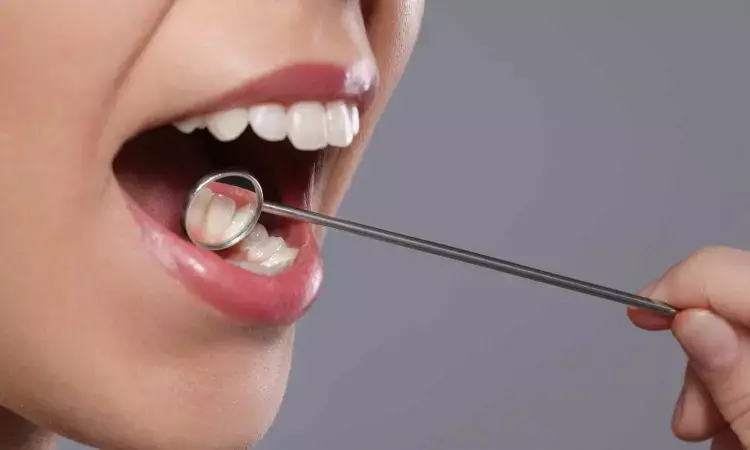- Home
- Medical news & Guidelines
- Anesthesiology
- Cardiology and CTVS
- Critical Care
- Dentistry
- Dermatology
- Diabetes and Endocrinology
- ENT
- Gastroenterology
- Medicine
- Nephrology
- Neurology
- Obstretics-Gynaecology
- Oncology
- Ophthalmology
- Orthopaedics
- Pediatrics-Neonatology
- Psychiatry
- Pulmonology
- Radiology
- Surgery
- Urology
- Laboratory Medicine
- Diet
- Nursing
- Paramedical
- Physiotherapy
- Health news
- Fact Check
- Bone Health Fact Check
- Brain Health Fact Check
- Cancer Related Fact Check
- Child Care Fact Check
- Dental and oral health fact check
- Diabetes and metabolic health fact check
- Diet and Nutrition Fact Check
- Eye and ENT Care Fact Check
- Fitness fact check
- Gut health fact check
- Heart health fact check
- Kidney health fact check
- Medical education fact check
- Men's health fact check
- Respiratory fact check
- Skin and hair care fact check
- Vaccine and Immunization fact check
- Women's health fact check
- AYUSH
- State News
- Andaman and Nicobar Islands
- Andhra Pradesh
- Arunachal Pradesh
- Assam
- Bihar
- Chandigarh
- Chattisgarh
- Dadra and Nagar Haveli
- Daman and Diu
- Delhi
- Goa
- Gujarat
- Haryana
- Himachal Pradesh
- Jammu & Kashmir
- Jharkhand
- Karnataka
- Kerala
- Ladakh
- Lakshadweep
- Madhya Pradesh
- Maharashtra
- Manipur
- Meghalaya
- Mizoram
- Nagaland
- Odisha
- Puducherry
- Punjab
- Rajasthan
- Sikkim
- Tamil Nadu
- Telangana
- Tripura
- Uttar Pradesh
- Uttrakhand
- West Bengal
- Medical Education
- Industry
Fiber-Reinforced Restorations Improve Fracture Resistance in Endodontically Treated Teeth: Study

A recent study published in Clinical Oral Investigations by Lena Bal, Cangul Keskin, Aybuke Karaca Sakall, Bilge Ozcan, investigated the effect of different reinforcement materials on the fracture resistance of mesio-occluso-distal (MOD) cavity restorations in endodontically treated teeth.
The researchers aimed to determine how applying fiber-reinforced composites to the cervical and coronal segments of teeth could impact their durability. This study is particularly relevant because vertical fractures in MOD restorations are among the most common failures observed in endodontically treated teeth, and improving restoration strength is essential for long-term success and preservation of dental function.
The study involved eighty-four freshly extracted human mandibular molars, prepared with standardized MOD cavities and endodontically treated. Teeth were divided into groups based on the combinations of reinforcement materials applied to the cervical and coronal segments, including flowable composite, posterior composite, EverX flow, EverX posterior, and Ribbond.
After thermocycling, fracture resistance was evaluated using a universal testing machine, and failure patterns were examined under a stereomicroscope. The authors reported that fiber-reinforced structures provided superior fracture resistance compared to conventional composites, particularly when applied to the cervical segment. This suggests that strategic placement of reinforcement materials in restorative procedures can enhance structural integrity, helping to reduce the risk of fractures in teeth subjected to functional load.
According to Bal et al., the findings underscore the clinical importance of material selection and placement in endodontic restorations. Fiber-reinforced composites were not only stronger than Ribbond but also packable and suitable for mesio-occluso-distal cavity restorations, making them practical for routine dental practice. The authors conclude that combining different resin-reinforced composites in cervical and coronal segments improves fracture resistance and provides a reliable method to enhance tooth durability after endodontic therapy. This study offers valuable guidance for dental professionals seeking evidence-based strategies to strengthen restorations and extend the longevity of endodontically treated teeth.
Dr. Shravani Dali has completed her BDS from Pravara institute of medical sciences, loni. Following which she extensively worked in the healthcare sector for 2+ years. She has been actively involved in writing blogs in field of health and wellness. Currently she is pursuing her Masters of public health-health administration from Tata institute of social sciences. She can be contacted at editorial@medicaldialogues.in.
Dr Kamal Kant Kohli-MBBS, DTCD- a chest specialist with more than 30 years of practice and a flair for writing clinical articles, Dr Kamal Kant Kohli joined Medical Dialogues as a Chief Editor of Medical News. Besides writing articles, as an editor, he proofreads and verifies all the medical content published on Medical Dialogues including those coming from journals, studies,medical conferences,guidelines etc. Email: drkohli@medicaldialogues.in. Contact no. 011-43720751


